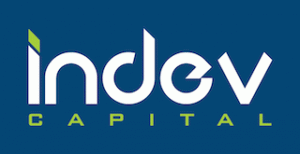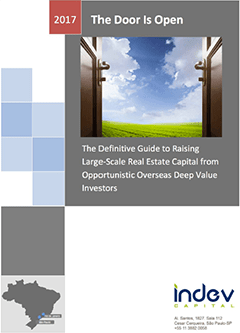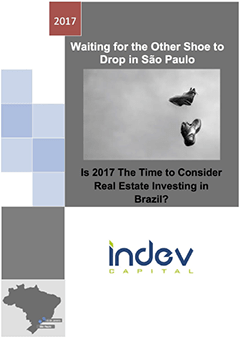
I have been traveling a lot lately (Spain, Johannesburg, South Africa etc) and read as much as possible on long flights. I recently came across this quote from Warren Buffet:
“Long ago, Ben Graham taught me that price is what you pay, value is what you get. Whether we’re talking about socks or stocks. I like buying quality merchandise when it is marked down.”
How did we get here?
Many smart investors have searched Brazil for distressed and/or value-priced real estate investment opportunities during the past 24 months. One of the complaints from these investors has been that the “bid to ask” spread was just too large. Investors demanded quality merchandise (real estate assets with existing streams of cash flow in good locations) “marked down,” per Warren Buffet’s teacher Benjamin Graham. Even in Brazil’s recent distressed environment, the price desired by sellers for such assets in 2015 was above the value of the asset in any reasonable valuation, particularly given the risk taken by the investor.
However, now in 2016 the situation has changed. We discussed these changes in our recent niche commercial floors newsletter. In addition, InDev, along with our Commercial Properties Brazilian Sponsor Group, demonstrated and analyzed live transactions in detail with investors with whom we had meetings in NYC in May. There is real evidence that the environment has shifted. Value is now above the price in many cases.
What specifically made the bid-ask spread tighten? No, it was not InDev’s market-moving power (I may quote Warren Buffet, but I can attest you that I am not the second richest American), nor is the rumor true that it was my persuasive personality (this has only gotten me a free coffee or a drink at a local bar.. Again no market movement has occurred by my smile.). The core reason for this change in the bid to ask spread is the recognition by sellers that this downturn in Brazil has no quick upturn. There is no easy button to be found for sellers to fix their need for liquidity. And now they have accepted it. Nothing more and nothing less has occurred.
 The high interest costs on balance sheets of seller’s assets (usually operating companies) drives sales of real estate assets currently. The bid-ask spread in Brazil has reached a point where significant value can be created in specific income-generating sectors of real estate.
The high interest costs on balance sheets of seller’s assets (usually operating companies) drives sales of real estate assets currently. The bid-ask spread in Brazil has reached a point where significant value can be created in specific income-generating sectors of real estate.
By the way, for those readers from the UK and other locales in Europe or Brazil not familiar with the concept of the easy button, please click for an easy button demonstration.
Build to Suit – Sale and LeaseBack Industrial Real Estate
Currently, there is a unique opportunity in the Build to Suit and Sale and LeaseBack (Industrial and Large Corporate Properties). This industrial and corporate property opportunity has similar characteristics to our Sao Paulo core focused niche commercial properties opportunity which are: one, motivated sellers; two, high current yield to costs; three, downside protection; and four, opportunity for significant IRR returns and equity multiples.
Build To Suit – Industrial Real Estate in Brazil: A Quick Market History
As most readers are aware, the cost of debt capital in Brazil is higher than in North America. In addition, the REIT (FII in Brazil) markets were almost non existent until the 2006 time frame. Hence, the early years of the build-to-suit market, 2002 onward, included very few players (WTorre, Rio Bravo, Hines, and Prosperitas) and there were very few funding sources. During the early period, the main funding sources were special lines of credit provided only by the largest local banks. Therefore, very few projects were executed.
As the Brazilian economy expanded, 2009 through 2012, the securitization market (CRI in Brazil) expanded. In addition, due to low interest rates, the Brazilian REIT (FII) market developed as well. The expansion of securitization and real estate investment trusts in Brazil was driven by low yields relative to competing alternatives, which in Brazil are NTN-Bs, government bonds tied to the SELIC, a government interest rate. The FII market also expanded due to a 150 basis point yield tax benefit for individual investors. During the expansion of the CRI (securitization) and FII (Brazil real estate investment trusts) markets, NTN-B’s offered very low yields.
In 2013, in order to tame inflation, Brazil faced an increasingly higher interest rate environment.Banks forecasted what would happen and tightened credit lines. Therefore, the Brazilian REIT (FII) and securitization (CRI) (both crucial for the BTS market) and the BTS market itself all slowed after 2013.
By 2015, the securitization market, except for only the highest quality contracts has effectively stopped, the Brazilian REIT market is also at a virtual standstill. The new development BTS market is for all practical purposes closed or at a micro scale of its pre-2013 pace.
Existing BTS Assets – Pre-2013 Vintage
Before 2013, high quality tenants were able to sign contracts that allowed developers to securitize this receivable for attractive interest rates of 4% to 7% per year (plus inflation, this is still Brazil!). The contracts were generally for 10 to 15 years. In fact, these BTS contracts went through a rent law change in year 2012 that made them even stronger contracts. The strong penalties for these contracts provide the market confidence that these BTS contracts are very enforceable. This created a ready market for securities tied to these contracts.
The perception of the Securitization market was that it was a method to own a great asset in the future, get a small bonus upfront for the work done, and wait for the tenant to pay the debt via the rent payments. If nothing had changed, it is a great business plan for a sponsor without a lot of equity. The key in the business model was the strength of the CRI or the securitization market which is heavily tied to interest rates and cycle of supply/demand for credit.
Importantly, mostly all BTS projects were financed a combination of equity (25% to 30%) and debt. Family offices, pension funds, and UHNW individuals invested in BTS, which had an inflation hedge with equity appreciation. However, as Brazilian interest rates increased, the interest level of these investors in BTS projects, or CRIs reduced greatly.
2016, Who are the Current Owners and why are they motivated to sell?
The BTS developer
The BTS developer lived and died off of the securitizations of long-term build-to-suit contracts. Hence, the firm expected and built its business model of the continuation of this market. With this market now stopped, this developer’s liquidity has also stopped (the large majority of the tenant payments are used to pay the debt of the securitization). These firms have now had two years with no work and now they need to raise capital and increase liquidity. These firms are motivated sellers. Importantly, many of these BTS developers’ projects likely have low-cost long-term debt in place that an investor can assume to boost IRR. Accretive debt in Brazil, yes it does exist! Could this be the Brazilian version of the Easy Button for an investor?
Family Office / UHNW (Ultra High Net Worth Individual)
Many family offices in Sao Paulo were heavily invested in commercial real estate floors (a key holding) right before the crisis started. Hence, those investments that are now completing development are not generating the yield expected. In fact, these commercial investments in 2013 are now coming into the market during a historic downturn and generate zero income. This was not expected by the owners. Ouch! Significant pain exists…. See below….

Moreover, in many situations currently, the operating company that serves as the engine of wealth for the family, is encumbered in high-cost-debt based on working capital loans whose costs could have as much as doubled in the past five years. These families desire liquidity and are motivated sellers of their build-to-suit assets.
Corporate Owners: family, non-family and multinationals
In Brazil, there is a high preference to own the real estate where a company’s factory is located. This orientation is a result of a historic struggle with inflation in Brazil. Among wealthy families, there is a general preference for real estate over equities due to real estate’s stronger inflation protection characteristics. Therefore many family-owned corporations and public listed companies with large majority shareholder owners are the owners of their industrial property. Today, due to similar characteristics above with family offices and the high costs of corporate debt, these owners believe a sale leaseback can solve their balance sheet problem. A 20%+ interest rate creates a very motivated seller.
Pension Funds
Top Brazilian public pension funds have lost over R$58 billion, or US $16.5 billion, since 2011 while their liabilities have steadily increased. If we include the devaluation of assets on their balance sheets, the total losses sum to over R$113.5 billion, or US$ 32.4 billion. Ouch! Again…
 The reasons for these losses are the following: one, bad investments, two, politically motivated investments, and unfortunately three, in some cases corruption. The result of these losses are that Pension Funds, once the largest net buyer of assets, are now potentially the largest seller of top-tier real estate assets.
The reasons for these losses are the following: one, bad investments, two, politically motivated investments, and unfortunately three, in some cases corruption. The result of these losses are that Pension Funds, once the largest net buyer of assets, are now potentially the largest seller of top-tier real estate assets.
What Types of Assets are Available?
Unique to this investment strategy, an investor can benefit from the hard work of the developer and owner of the current asset. Why? The most difficult work of the BTS project is done: sourcing a top-tier contract with a great tenant. The investor can step in early in the lease, purchase at a price below the value of the property, and enjoy the benefits of a great asset with a high yield. The assets that are available in the market currently have the following characteristics:
I. Long Term Cash Flow – minimum contract length is 10 years and up to 15 years.
II. Purchase Price at approximately 12% net yield to costs. It is a buyers’ market
III. Top-Tier Underwriting – Ability to choose from the best projects per use of a local sponsor group
IV. Ability to build a high quality portfolio of assets
V. Top-Tier Tenants and real estate assets that are strategically important to the tenant’s operation
VI. Limited Competition, FII and CRI markets are shut,
VII. Accretive and inexpensive, relative for Brazil, debt in place (tendency of reduction of interest rate). Ability to juice portfolio returns by assuming existing asset level lower cost debt
The characteristics that an investor should focus on are the following: one, credit of the tenant; two, multiple uses of facility; three, importance of facility to tenant; four, remaining length of lease; and five, real estate appreciation value.
Future Liquidity: Perfect Storm Created Buying Opportunity – Liquidity Left BTS market

The perfect storm that has created this investment opportunity is the following: one, high interest rates caused NTN-B’s to become the preferred investment choice for UHNW and Family offices. This led to large capital reducing their desire for BTS investments; two, securitization (CRI’s) are all but impossible to sell in this environment based on the same aforementioned reason. This not only limits new supply but it also limits potential buyers; and three, the Brazilian REIT market is effectively closed. There is very little market liquidity.
Political Situation: Governing with a Bullet To Everyone’s Head…

One way to look at the recent political changes in Brazil is to take Winston Churchill’s quote about the USA, “You can always count on Americans to do the right thing – after they have tried everything else,” and tropicalize it for Brazil to say, “You can always count on Brazilians to do the right thing – after they have tried everything else… AND have waited until absolutely the last minute.”
The new Temer Administration appears to be moving in the right direction early in his term. A sense of urgency permeates his administration. First, he has put together an all-star team of political heavyweights and most impressively, an economic team, that has provided confidence to the markets. It is Brazil, and two of his early appointees had to leave office within 10 days due to potential involvement (per audio-taped recording) in the Operation Lava Jato (Car Wash) Scandal.
Brazil’s economic crisis is partly due to the end of the commodity super-cycle, but a large part of the crisis has been due to a full loss of confidence by the business community in the previous administration’s handling of the economy and the country’s fiscal account. Temer has made some initial moves to show that he has the confidence of congressmen in the lower house and senators in the upper house.
While mostly symbolic, the recent 2016 budget approval of a R$170B deficit was an example of this confidence-building measure. It was approved by a large majority. While the number is larger than predicted by Dilma, unlike previous administrations which would propose a low fiscal budget and then break it and ruin confidence, this administration desires to hold its word.
The key in Temer’s interim term is his effort to shrink the size of the government. Brazil has a history of a bloated state system, not known for its efficiency. The government is working on a constitutional amendment to freeze public spending at 2016 levels. This will stop the unsustainable populist spending increases that were causing the large increase in the fiscal deficit. Temer will need to work to delink revenue streams tied to health and education spending. Importantly, he will also have to delink automatic inflation adjustments in pension funds, minimum wage, and public sector wages. In a normal environment these measures would be near impossible, but per our interpretation of Winston Churchill’s statement about the USA for Brazil, the alternatives of executing these measures to stop the ballooning fiscal deficit are much worse. Temer’s advantage is that he can literally say, “If we commit an error here, we will all be held responsible for the disaster.”
So How Does an Exit Work – A Brazilian Recovery for a Real Estate Investor Nowhere to Go But Up
Per progress in the fiscal situation, which is moving ahead daily, investors can assume positive direction of the economy in 2017-2018 time frame. During this period, an investor can intelligently build a high-quality portfolio with a going in yield-to-costs of roughly 12% in top-tier assets. The exit options get quite interesting.
The key economic numbers that will drive value for a build-to-suit portfolio will be Brazilian interest rates. As the Selic rate approaches 10%, NTN-Bs will then be less than double digits. At this point, Brazilian Pension Funds, UHNW, and Individuals, seek yield and inflation protection provided by long-term real estate. These markets open up again and the real estate cycle continues.
InDev Capital will be in NYC in early July with a Brazilian sponsor with significant experience in the build-to-suit space and a pipeline of over $100M in equity. The sponsor’s goal is to build a unique portfolio of high-quality build-to-suit assets at this time in the real estate cycle in Brazil.
Warm Regards and Thanks for Reading!

Joseph W. Williams
CEO & Founder InDev Capital




